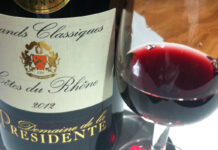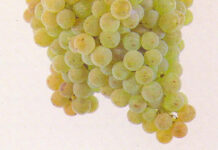Luke Richardson is the sommelier at wine bar Le Di-Vin in Edinburgh. In his column for SLTN he shares his thoughts on all things wine-related and answers your questions about wine. If you have a question for Luke email it to sltn@peeblesmedia.com

Hi all, and welcome back to my monthly wine column.
This time we are going to look at the Chardonnay grape variety, which might very well take two or more columns to attempt to cover, mainly because Chardonnay can be made into nearly every white wine style there is – from the crisp, mineral and taut style of a good Chablis, through the medium-bodied and fruity unoaked styles that account for a good chunk of this grape variety’s production, to the rich, buttery and oaky style you would find in California and the myriad of styles available in the grape’s spiritual home, Burgundy!
It is the most versatile white grape out there, and very much a winemaker’s favourite – often seen as a good grape to use as a starter, to break into the world of wine.
Firstly, let’s look at what affects the flavours of Chardonnay – in a lot of ways, it is a very neutral grape that relies on the terroir and the finishing method for many of its flavours… but there are a few general attributes that can be noted.
For a start, the climate is hugely important – cool climate Chardonnay tends to be on the lighter end of the spectrum, with crisp acidity and often without oak influence. These unoaked styles tend to have similar flavours to greengage, apple or pear, with just a little texture in the mouth and a lemon-like acidity on the finish.
As the climates get hotter, the fruit tends to change to a riper style – think peach, melon or guava, and, although the acidity is still roughly citrus, it’s more like a baked lemon style – a little less bright, a touch more mellow.
In really hot climates, the fruit flavours taste more like fig, honey, mango or even banana – the super sweet fruits. This does not mean that the wines themselves have any more sweetness to them, but the flavours they remind us of get riper the hotter the climate is.
The next thing to take into account is the way that the wine has been aged – ie. if it was aged in oak barrels, what type of oak was used, and for how long was the wine in contact with said oak? The longer the oak is in contact with the wine, the more of an influence it will have.
The main flavour influencers from oak-ageing are either toasty, smoky flavours (from using new oak barrels) or nutty, buttery flavours (from using older oak barrels). For example, if you make a wine and age it for three or four months in new oak, there will be a hint of toasty and smoky flavours on the finish of the wine, but it will retain most of its acidity and freshness with just a hint of richness to the texture.
If you left the same wine for, say, a year in new oak barrels, the smoky and toasty flavours would be much stronger, and that longer period of time on the oak would also mute down the acidity to make the wine seem much fatter and richer.
Although generalisations can be problematic in the world of wine, the hotter climate wines tend to lend themselves more to heavy oak-ageing, as the generosity of those riper fruits soak up some of the more acrid flavours of the oak.
Next time we will look at some examples, but until then, cheers!




















